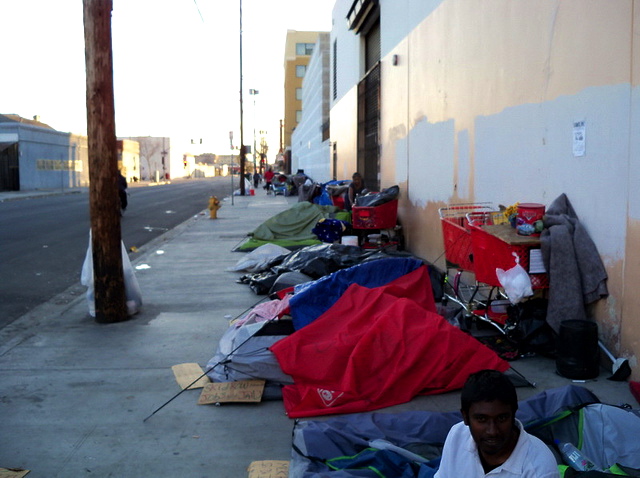L.A. Homeless Count Needs Your Help

Under dimly lit streetlights and the distant glare of every major U.S. bank in downtown Los Angeles, hundreds of adults wait for food in the rain on crowded, filthy streets. Some are sick, others are veterans, many are mentally ill.
Categorically, they are homeless.
L.A. County has the largest number of homeless people in the country, with the vast majority largest numbers living in Metro and South L.A. Of the more than 51,000 estimated homeless people currently residing in L.A., a staggering 40% -- nearly 20,000 homeless people -- reside on the streets or in shelters in these areas, according to the Los Angeles Homeless Services Authority (LAHSA).
From Jan. 29-31, L.A. will hold the fifth biannual Greater Los Angeles Homeless Count, the largest homeless count in the nation. Within each geographic area of L.A., the census will attempt to register homeless individuals in terms of gender, race, age and marital status. It will also aim to determine the number of homeless residents living with severe mental illness, disabilities, drug dependency and/or HIV, as well as veterans, survivors of domestic abuse and homeless families.
“The more information we have, the more we can do,” said Jerry Hittleman, director of policy and planning for LAHSA, which organizes the count.
The count is a necessary measure for LAHSA and other homeless advocacy organizations to continue receiving funding and resources from the US Department of Housing and Urban Development (HUD). Aside from collecting sheer numbers, the census will aim to uncover shifts in trends of the homeless population, with South L.A. being a distinct focus of the count.
South L.A. has increasingly become a hub for many at-risk groups of homeless individuals. Findings from the 2011 L.A. Homeless Count revealed that 37% of unaccompanied homeless youth (persons 18 and under) and 33% of homeless family members (individuals with relatives also living on the streets) were living in South L.A.
“Homeless youth in South L.A. are often the product of the neighborhood: the foster care system, problems coming out of prison, youth detention centers. Others come from broken homes, single family homes,” said Hittleman.
There is also the stark reality of joblessness in South L.A. which is approximately 16% compared to 9.5% for the greater city. In southern parts of South L.A., it can be as high as 25%, for African American males as high as 35%.
South L.A. encompasses a total of 28 neighborhoods, from historic South Central in the north to Watts and Athens in the south, Crenshaw and West Adams in the west to Florence Graham in the east. With increased development in Downtown L.A., many local advocates believe that homeless populations in South L.A. are growing as a result.
Grace Weltman is a case manager for LAHSA covering South L.A. Weltman pointed to the high number of child welfare cases as a key factor that contributes to the high levels of homeless in the region.
“About 55% of child welfare cases in L.A. occur in communities in South L.A. These kids often end up on probation or having severe mental health issues. We also see many children from the foster care system who turn eighteen and find themselves suddenly without a home,” said Weltman.
Supervisor Mark Ridley-Thomas oversees a district that encompasses both Metro and South L.A., the greatest number of homeless persons in any supervisorial district. Ridley-Thomas recently issued a public call-to-action encouraging L.A. residents to participate in the 2013 Homeless Count. He is expected to be volunteering in the count in his district this week.
Some homeless advocates questioned the effectiveness of the count. Mel Tillekeratne, the chief organizer of Monday Night Mission, a grassroots volunteer organization that helps feed homeless people living on and around Skid Row, noted that the count was taking place during the winter.
“It’s cold, and because of that many homeless people disperse", argued Tillekeratne. “Tonight we served food to a couple hundred people. In June or July, the number would be double that. If they want an accurate number, it should be held at a different time.”
While some neighborhoods have high numbers of volunteers registered for the 2013 L.A. Homeless Count, many areas in South L.A. including neighborhoods around USC remain in desperate need of help.
“These people are human beings. They deserve better than this,” said Tillekeratne.
To learn more about the 2013 L.A. Homeless Count and volunteer, visit: http://www.theywillcountyou.org.
To learn more about Monday Night Mission and volunteer, visit: http://www.mondaynightmission.org
Reach staff reporter Ashley Riegle by email. Follow her on Twitter here.



